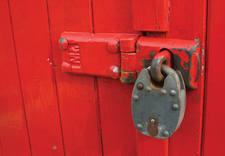HTTPS out of the box with the Caddy secure web server
Simply Secure

Lead Image © stockers9, photocase.com
Caddy lets even the most inexperienced user set up a secure web server.
After hundreds of high-profile attacks on large and small websites, the web world is gradually giving up on old-fashioned, unsafe, unencrypted HTTP and is moving to the safer, encrypted variant known as HTTPS. HTTPS is based on the SSL/TSL protocols, which means you need to install, maintain, and regularly renew digital certificates for the website. The certificates are only valid for a limited period, which can vary between three months to 10 years, depending on the certificate authority.
All the major web servers, such as the Apache HTTP server, Microsoft's Internet Information Services (IIS), and Nginx, provide some means for HTTPS support, but the configuration steps are often complicated and more trouble than you need, especially if you just operate a small website.
Caddy [1] is a simple and easy web server that delivers simple and convenient HTTPS support. Caddy uses the Let's Encrypt [2] project for easy access to free digital certificates. (See the box titled "Simply Encrypted.") Caddy also includes support for HTTP/2 (see "From HTTP 1.1 to HTTP/2"), and it comes with other useful features, such as support for the Markdown and AsciiDoc formatting languages.
[...]
Buy this article as PDF
(incl. VAT)
Buy Linux Magazine
Subscribe to our Linux Newsletters
Find Linux and Open Source Jobs
Subscribe to our ADMIN Newsletters
Support Our Work
Linux Magazine content is made possible with support from readers like you. Please consider contributing when you’ve found an article to be beneficial.

News
-
Two New Distros Adopt Enlightenment
MX Moksha and AV Linux 25 join ranks with Bodhi Linux and embrace the Enlightenment desktop.
-
Solus Linux 4.8 Removes Python 2
Solus Linux 4.8 has been released with the latest Linux kernel, updated desktops, and a key removal.
-
Zorin OS 18 Hits over a Million Downloads
If you doubt Linux isn't gaining popularity, you only have to look at Zorin OS's download numbers.
-
TUXEDO Computers Scraps Snapdragon X1E-Based Laptop
Due to issues with a Snapdragon CPU, TUXEDO Computers has cancelled its plans to release a laptop based on this elite hardware.
-
Debian Unleashes Debian Libre Live
Debian Libre Live keeps your machine free of proprietary software.
-
Valve Announces Pending Release of Steam Machine
Shout it to the heavens: Steam Machine, powered by Linux, is set to arrive in 2026.
-
Happy Birthday, ADMIN Magazine!
ADMIN is celebrating its 15th anniversary with issue #90.
-
Another Linux Malware Discovered
Russian hackers use Hyper-V to hide malware within Linux virtual machines.
-
TUXEDO Computers Announces a New InfinityBook
TUXEDO Computers is at it again with a new InfinityBook that will meet your professional and gaming needs.
-
SUSE Dives into the Agentic AI Pool
SUSE becomes the first open source company to adopt agentic AI with SUSE Enterprise Linux 16.

